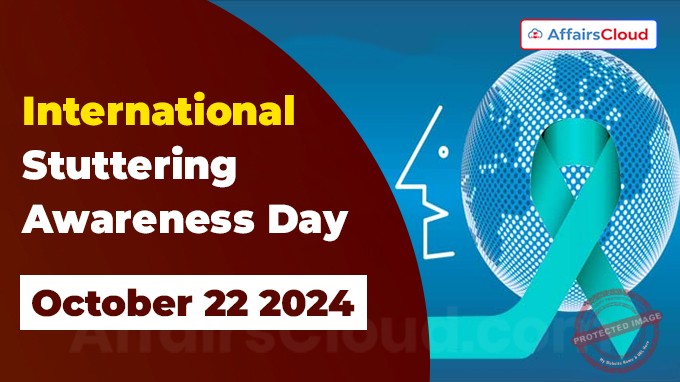 International Stuttering Awareness Day(ISAD) also known as International Stammering Awareness Day is annually observed across the globe on 22 October to raise awareness about stuttering (a speech disorder), promote understanding and support those affected by this disorder.
International Stuttering Awareness Day(ISAD) also known as International Stammering Awareness Day is annually observed across the globe on 22 October to raise awareness about stuttering (a speech disorder), promote understanding and support those affected by this disorder.
Theme:
The theme of ISAD 2024 is- “The Power Of Listening – People Who Stutter Have the Unique Opportunity to Teach the World to Listen.”
- This theme emphasizes the importance of active listening and understanding in communication. It encourages society to appreciate the perspectives and experiences of individuals who stutter.
Background:
i.In 1997, ISAD was first proposed by Michael Sugarman, the co-founder of the National Stuttering Project (NSP) during the closing ceremony of the International Fluency Association (IFA) in San Francisco, California, the United States of America (USA).
ii.In 1998, the European league of Stuttering Associations (ELSA), the IFA, and the International Stuttering Association (ISA) declared the 22nd October of every year as “International Stuttering Awareness Day”
iii.The first ISAD was observed on 22 October 1998.
Note: The year 2004 was designated by the IFA, ISA, and the ELSA as the International Year 2004 Children Who Stutter.
Symbol:
Since 2009, the Sea-Green Ribbon has been used as a stuttering awareness ribbon for ISAD
- The color “blue” is traditionally associated with the “calm” and “green” represents “liberty”, freedom and justice.”
Note– The Annual Sea-Green Ribbon Campaign aims to spread awareness about all mental health difficulties to help end mental health stigma and discrimination.
2024 ISAD Online Conference:
i.This year’s Online Conference runs from October 1 to October 31, 2024.
ii.It celebrates the 27th edition of the online conference and acknowledges the various events taking place worldwide on ISAD.
What is Stuttering?
Stuttering is a speech disorder that affects the flow of speech. It can cause interruptions in a person’s speaking pattern, leading to repetitions of sounds, syllables, or words, as well as prolonged sounds or pauses.
- Stuttering can vary in severity and may be influenced by stress, excitement, or anxiety.
Types: The main types include developmental stuttering, neurogenic stuttering, psychogenic stuttering, and cluttering.
Key Facts:
According to the National Institute of Deafness and Other Communication Disorders (NIDCD):
- Stuttering impacts approximately 5 to 10% of children at some stage in their development, typically occurring between the ages of 2 and 6.
- Approximately 75% of children recover from stuttering.
- For the Remaining 25% who continue to stutter, stuttering can persist as a lifelong communication disorder.
About International Stuttering Association (ISA):
Chair– Douglas Scott
Headquarters– Minnesota, the United States of America(USA)
Founded -1995




